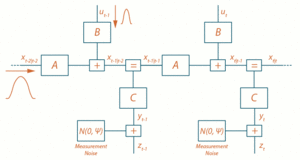Parameter and State Estimation
Physiological Systems
In contrast to most technical systems, medical applications often do not allow for a proper instrumentation with sensors to measure the most relevant quantities. For instance in the cardio-pulmonary system the most central quantity, cardiac output, can only be measured invasively by entering a catheter into the heart. Mechanical properties of the lung, while highly relevant for setting up a lung protective ventilation scheme in mechanically ventilated patients, are difficult to measure as long as the patient is breathing spontaneously to some degree. For many other quantities no generally accepted measure is known. At the IME we work on state and parameter estimation schemes allowing to quantify these unknown quantities by combining the information of a dynamical model with indirect sensor information.
Message Passing on Factor Graphs
Most modern design methodologies in signal processing and control rely on dynamical models of the underlying process. Identifying model parameters as well as the current state of the system is thus one of the main challenges in automatic control and signal processing. At the IME we develop new methods for estimating states and parameters of dynamical systems using message passing on factor graphs.
Factor graphs provide a way to represent the structure of a probability density function by means of a graph. Computations on this probability density function, such as inference problems, can hence be performed by means of message propagation along this graph. By varying the structure of the graph, the type of messages passed, as well as the order and direction of propagation, a large variety of algorithms can be described in a standardized way. At the IME we work on
- Novel algorithms,
- Algorithmic stability and convergence,
- Simplified exposition of computational schemes, and
- Numerical issues.

- Research
- Mechanical Ventilation
- Parameter and State Estimation
- Ethical Innovation Lab
- Autonomous Systems Lab
Members
Philipp Rostalski

Gebäude 19
philipp.rostalski(at)uni-luebeck.de
+49 451 3101 6200
Christian Herzog, né Hoffmann

Gebäude 64
,
Raum 106
christian.herzog(at)uni-luebeck.de
+49 451 3101 6211



